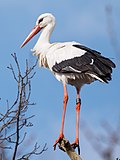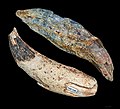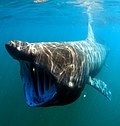The Rupelian is, in the geologic timescale, the older of two ages or the lower of two stages of the Oligocene Epoch/Series. It spans the time between 33...
8 KB (607 words) - 20:18, 18 November 2024
of a broader trend of global cooling lasting from the Bartonian to the Rupelian. The transition is marked by the Oi1 event, an oxygen isotope excursion...
72 KB (7,991 words) - 08:45, 12 November 2024
extinct. First neocetes (modern, fully aquatic whales) appear. 27.82 * Rupelian 33.9 * Eocene Priabonian Moderate, cooling climate. Archaic mammals (e...
174 KB (9,743 words) - 01:50, 14 November 2024
fossil leafy shots of †Cryptomeria yunnanensis have been described from Rupelian stage strata of the Lühe Basin in Yunnan, China. From the Neogene, Cryptomeria...
19 KB (1,905 words) - 06:08, 25 April 2024
Oligocene−Rupelian vertebrate record in North America. White River Formation prehistoric fauna Chadronian — Priabonian, Rupelian Orellan — Rupelian DonaldProthero...
4 KB (167 words) - 09:19, 18 November 2024
of Bathynomus are known extending back to at least the Early Oligocene (Rupelian) of Italy, with other fossils being known from Japan and Spain. Lowry,...
21 KB (2,383 words) - 09:05, 4 November 2024
spans the time between 27.82 and 23.03 Ma. The Chattian is preceded by the Rupelian and is followed by the Aquitanian (the lowest stage of the Miocene). The...
9 KB (754 words) - 19:42, 18 November 2024
Hummingbird (category Extant Rupelian first appearances)
years ago. The oldest known fossil hummingbird is Eurotrochilus, from the Rupelian Stage of Early Oligocene Europe. Hummingbirds are the smallest known and...
165 KB (17,670 words) - 04:25, 14 November 2024
Rupel (category Rupelian)
The Rupel is navigable, and forms part of the waterway to Brussels. The Rupelian Age of the Oligocene Epoch in the geological time scale is named after...
1 KB (106 words) - 22:09, 24 August 2024
Stork (category Extant Rupelian first appearances)
Storks are large, long-legged, long-necked wading birds with long, stout bills. They belong to the family Ciconiidae, and make up the order Ciconiiformes...
49 KB (5,483 words) - 09:22, 10 November 2024
Cicimurri, J. L. Knight, J. A. Ebersole (March 2022). "Early Oligocene (Rupelian) fishes (Chondrichthyes, Osteichthyes) from the Ashley Formation (Cooper...
19 KB (1,620 words) - 21:51, 6 October 2024
Miocene Danian Selandian Thanetian Ypresian Lutetian Bartonian Priabonian Rupelian Chattian Subdivision of the Paleogene according to the ICS, as...
107 KB (11,853 words) - 08:38, 12 November 2024
and lasted from 33.9 Ma to 23.03 Ma. It is divided into two stages: the Rupelian 33.9 Ma to 27.82 Ma; and, Chattian 27.82 - 23.03 Ma. The GSSP for the base...
65 KB (7,345 words) - 08:29, 12 November 2024
Flying squirrel (category Extant Rupelian first appearances)
Flying squirrels (scientifically known as Pteromyini or Petauristini) are a tribe of 50 species of squirrels in the family Sciuridae. Despite their name...
28 KB (3,152 words) - 08:22, 11 November 2024
Ma. The Priabonian is preceded by the Bartonian and is followed by the Rupelian, the lowest stage of the Oligocene. Priabona, an extinct dipteran of Pipunculidae...
9 KB (678 words) - 20:15, 18 November 2024
Africtis (category Rupelian genera)
is an extinct genus of carnivoramorph that inhabited Libya during the Rupelian. It is a monotypic genus that contains a single species, Africtis sirtensis...
1 KB (86 words) - 21:22, 11 November 2024
Formation of Colorado, while the last occurrences are in the Early Oligocene, Rupelian of the Bridge Creek Flora in the upper John Day Formation. Concurrently...
6 KB (642 words) - 00:39, 14 August 2024
and sp. nov., a new skeleton-based Carangid Fish from the Boom Clay (Rupelian, Early Oligocene) at Kallo (N. Belgium)". Bulletin de l'Institut Royal...
9 KB (751 words) - 10:48, 19 October 2024
Entelodon (category Rupelian genus extinctions)
Paleogene strata ranging in age from the Houldjinian (37.2–33.9 mya) until the Rupelian epoch of the early Oligocene (33.9–28.4 mya). It is one of four entelodont...
7 KB (612 words) - 19:49, 18 November 2024
Tyler & Gregorova, 1991 Oligolactoria bubiki Tyler & Gregorova, 1991 (Rupelian of Moravia, Oligocene Czech Republic) There are about 25 recognized extant...
8 KB (835 words) - 02:31, 15 November 2024
Sloth (category Extant Rupelian first appearances)
Sloths are a Neotropical group of xenarthran mammals constituting the suborder Folivora, including the extant arboreal tree sloths and extinct terrestrial...
50 KB (5,432 words) - 03:14, 21 October 2024
Tarab Formation (category Rupelian Stage)
western Libya. The lacustrine limestones preserve fossils dating back to the Rupelian stage of the Oligocene period. The formation has provided the following...
3 KB (126 words) - 04:55, 19 November 2024
the oldest fossils of the genus being seeds from the Early Oligocene (Rupelian) of Oregon, USA. Fossil species are also known from the Late Oligocene...
9 KB (974 words) - 00:12, 15 August 2024
Deer (category Extant Rupelian first appearances)
A deer (pl.: deer) or true deer is a hoofed ruminant ungulate of the family Cervidae (informally the deer family). Cervidae is divided into subfamilies...
95 KB (10,318 words) - 02:49, 26 October 2024
Basking shark (category Extant Rupelian first appearances)
The basking shark (Cetorhinus maximus) is the second-largest living shark and fish, after the whale shark. It is one of three plankton-eating shark species...
40 KB (4,154 words) - 02:06, 15 October 2024
extinct genus of testudinid that lived in what is now France during the Rupelian stage of the Cenozoic era. It is known from a single species, T. gigas...
1 KB (76 words) - 12:32, 8 October 2024
Desmostylia (category Rupelian first appearances)
aquatic mammals native to the North Pacific from the early Oligocene (Rupelian) to the late Miocene (Tortonian) (30.8 to 7.25 million years ago). Desmostylians...
23 KB (2,201 words) - 04:46, 19 November 2024
Phasianidae (category Extant Rupelian first appearances)
The Phasianidae are a family of heavy, ground-living birds, which includes pheasants, partridges, junglefowl, chickens, turkeys, Old World quail, and peafowl...
32 KB (2,346 words) - 01:59, 19 October 2024
Pomfret (category Extant Rupelian first appearances)
Pomfrets are scombriform fish belonging to the family Bramidae. The family currently includes 20 species across seven genera. Several species are important...
5 KB (355 words) - 21:05, 5 November 2024
New World monkey (category Extant Rupelian first appearances)
New World monkeys are the five families of primates that are found in the tropical regions of Mexico, Central and South America: Callitrichidae, Cebidae...
19 KB (2,061 words) - 15:51, 22 November 2024























